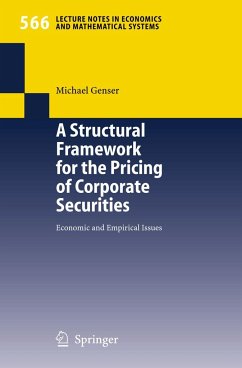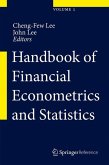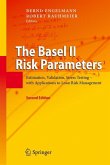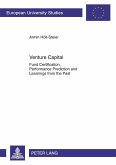This book is the first comprehensive treatment of structural credit risk models for the simultaneous and consistent pricing of corporate securities. Through the development of a flexible economic framework based on the firm's EBIT, the reader is taken from the economic principles of firm value models to the empirical implementation. Analytical solutions are provided if EBIT follows an arithmetic or geometric Brownian motion. In addition, numerical methods are proposed to solve more advanced economic settings or to price derivatives on corporate securities. Numerical examples make the theory easily accessible and show its ability to reproduce empirical observations. An econometric implementation guides towards practical application. Hence, the book provides a state-of-the-art exposition of corporate securities pricing for academics and practitioners alike.
In the last few years, a re?ned pricing of corporate securities has come intofocusofacademicsandpractitioners.Asempiricalresearchshowed, traditionalassetpricingmodelscouldnotpricecorporatesecuritiess- ?ciently well. Time series properties of quoted securities were di?cult to replicate. In the search for more advanced models that capture the empirical ?ndings, researchers followed two approaches. The ?rst stream of - search ?tted the time series properties of corporate securities directly. Werefertothisclassofmodelsasbeingofreducedform.Securityprices are assumed to follow more advanced stochastic models, in particular 1 models withe.g. non-constant volatility. All studiesofthistypedonot consider the economics of the issuing companies but simply assume a stochastic behavior of the security or its state variables. In contrast, a second, economic literature developed by studying the ?rm. We call these kinds of models structural because the limited liability of equity holders is modeled explicitly as a function of ?rm value. One problem of the reduced form approach is its di?culty of int- pretation in an economic sense. Being technically advanced, reduced form models often lack an intuitive economic model and especially d- guise the economic assumptions. If security pricing is the only purpose of the exercise, we might not need an economic model. However, if we wanttounderstandpricemovements,aseriouslinkwiththeunderlying economics appears important. Thecreditriskliteratureevenadoptedthisparticularterminologyto 2 categorize its models. Whereas reduced form models take each corpo- 1 See e.g. Stein and Stein (1991) for a stochastic volatility model and Heston and Nandi (2000) on GARCH option pricing.
In the last few years, a re?ned pricing of corporate securities has come intofocusofacademicsandpractitioners.Asempiricalresearchshowed, traditionalassetpricingmodelscouldnotpricecorporatesecuritiess- ?ciently well. Time series properties of quoted securities were di?cult to replicate. In the search for more advanced models that capture the empirical ?ndings, researchers followed two approaches. The ?rst stream of - search ?tted the time series properties of corporate securities directly. Werefertothisclassofmodelsasbeingofreducedform.Securityprices are assumed to follow more advanced stochastic models, in particular 1 models withe.g. non-constant volatility. All studiesofthistypedonot consider the economics of the issuing companies but simply assume a stochastic behavior of the security or its state variables. In contrast, a second, economic literature developed by studying the ?rm. We call these kinds of models structural because the limited liability of equity holders is modeled explicitly as a function of ?rm value. One problem of the reduced form approach is its di?culty of int- pretation in an economic sense. Being technically advanced, reduced form models often lack an intuitive economic model and especially d- guise the economic assumptions. If security pricing is the only purpose of the exercise, we might not need an economic model. However, if we wanttounderstandpricemovements,aseriouslinkwiththeunderlying economics appears important. Thecreditriskliteratureevenadoptedthisparticularterminologyto 2 categorize its models. Whereas reduced form models take each corpo- 1 See e.g. Stein and Stein (1991) for a stochastic volatility model and Heston and Nandi (2000) on GARCH option pricing.








